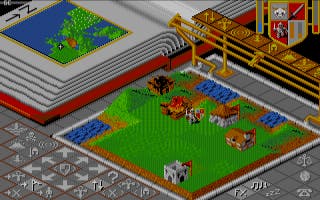Games That Define Developers
Molyneux, Willits, Takahashi and 15 others tell us which one game has influenced them most.
Journalists often ask creators what influences them, and the answer is usually that we draw influence from everywhere - films, books, music, television, the walk to work, that time we tripped over the bathmat...
But game creators, just like film directors, musicians, novelists and X-Factor hopefuls, are all influenced by the things in their own medium that speak to their tastes most directly. Sometimes they alter those tastes in the process. Nor are creators always conscious of their most significant influences, which makes it all the most interesting.
It's a fascinating subject and one we've wanted to explore for a long time. With that in mind, recently we've been privileged to speak to some of the world's top game creators and we asked all of them: which one game has been most influential on you as a game developer?
Read on to find out what everyone from Peter Molyneux and Tim Willits to Jonathan Blow and Keita Takahashi had to say about the games that helped to define their careers.
Jonathan Blow is the creator of award-winning indie game Braid and is currently developing The Witness.
"Counter-Strike is influential because subtlety really matters in that game. What the texture is on a wall at the end of a long hallway matters hugely, because then that controls how well you can see whether a guy steps in front of it with a sniper rifle, and that determines your reaction time.
"Or, if you're playing Dust, or one of those levels that gets played to death, and you're pinned down in that centre area where everybody always gets pinned down, because the sound effects are different you're like, 'Okay, there's a guy with an AK off to the left and I know he's probably behind the left side because I've got all this experience of playing this level, and I heard a sniper shot, so he's probably behind those crates looking down under the hallway, and the guy with the bomb just died, so they're probably covering the bomb, so I probably need to...'
"You make all these plans based this holographic imaging of the level that happens in your head, which is based on very subtle things and player experience, and I find that very valuable. The Witness values subtlety in that same way, in a very different kind of game design."

Tim Willits is creative director at id Software on RAGE, having previously worked on everything from Quake to Doom III.
"Doom 1. That is an easy question.
"When I downloaded the shareware episode of Doom, I actually thought that the whole demo was that first room in Doom 1. Which was pretty cool - I could walk around, pick stuff up, shoot my gun and so on. But I didn't figure out there was a door because it kind of looked like a wall.
"I moved up to it, somehow I hit spacebar and it opened, and I was like, 'Woah.' And that was the defining moment of my life."
Mike Simpson is studio director of The Creative Assembly, and is best known as the driving force behind the Total War strategy series.
"It's probably the original board game version of Dungeons & Dragons. That was before computer games existed, or around the same time as Pong and stuff. That's what caused me to end up making computer games: it was very natural to go from playing them a lot to making games."
Tameem Antoniades is one of the co-founders of British studio Ninja Theory, which recently finished work on Enslaved: Odyssey to the West and is producing a new Devil May Cry game for Capcom.
"I would probably have to go with Half-Life, the original. It achieved something that was way ahead of its time, and whether you're making a first-person or a third-person action game, the level design in that game and the way it melded with the story was second to none.
"In meetings and design meetings we still refer back to that game."

Dave Perry is CEO of Gaikai and in a previous life co-founded MDK developer Shiny Entertainment.
"I played Populous and by god I learnt a lot from that and Peter Molyneux. I've watched his whole career and played all of his games.
"I can talk about individual moments in lots of titles, and I apply that when I'm talking to students and I review their game designs. If you say ZT Online to most western game designers, they'll be like, 'What's that?' They make $100,000 from a single player, and the game looks like it was made in 1995. It's isometric 3D. Why haven't you played that one? Did you know the company that made it's called Giant Interactive, and they listed on the New York Stock Exchange based on that game for $3 billion? What?"
Keita Takahashi is the creator of Katamari Damacy and Noby Noby Boy. These days he designs playgrounds, among other things.
"It's a game by Sony that wasn't released. It's called Densen in Japanese, which means power line. It's where a girl hangs a clothes hanger on a power line, and then she slides on it.
"That's what the game's about. I was really shocked by the implementation of the normal things we see in our daily lives - just by changing the way we view things. It was amazing how they made it into a game.
"It was on PlayStation 2. Maybe they found it difficult to complete it as a videogame. I haven't played the game. I just saw a demo video."

